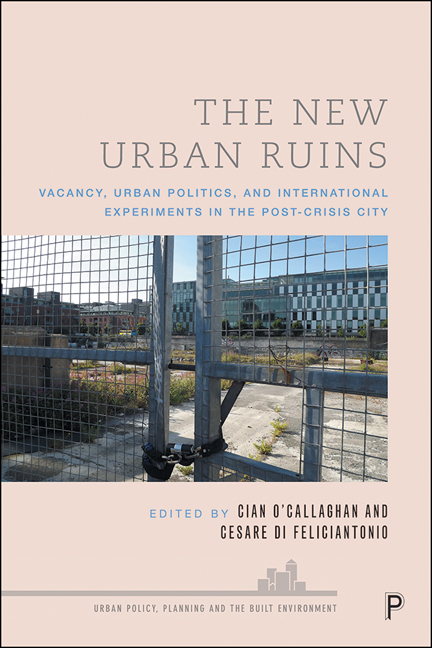Book contents
- Frontmatter
- Contents
- List of figures and tables
- Notes on contributors
- Acknowledgements
- Introduction
- PART I Rethinking ruination in the post-crisis context
- PART II The political economy of urban vacant space
- PART III Reappropriating urban vacant spaces
- Conclusion: Centring vacancy – towards a research agenda
- Index
8 - The post-crisis properties of demolishing Detroit, Michigan
Published online by Cambridge University Press: 13 May 2022
- Frontmatter
- Contents
- List of figures and tables
- Notes on contributors
- Acknowledgements
- Introduction
- PART I Rethinking ruination in the post-crisis context
- PART II The political economy of urban vacant space
- PART III Reappropriating urban vacant spaces
- Conclusion: Centring vacancy – towards a research agenda
- Index
Summary
Placing and planning demolition
Between 2005 and 2015, nearly 140,000 homes in Detroit faced mortgage or tax foreclosure. The Great Recession obliterated black wealth, shattered neighbourhoods and intensified economic uncertainty in US metropolises already weakened by decades of institutionalised segregation and population loss (Kurth and MacDonald, 2015). Over the course of just a few years, residents of Detroit fled in numbers bested only by New Orleans, LA, during the post-Hurricane Katrina flight. In May 2014, Motor City Mapping – a project of the public–private Detroit Blight Removal Task Force (DBRTF) – identified 78,000 buildings in some state of disrepair. DBRTF leaders concluded over 40,000 of these structures needed immediate demolition (Clark, 2014). The largest residential demolition programme in US history began awarding contracts that summer (Dolan, 2014).
For many, smashing these empty structures was common sense to escape the aftermath of the Great Recession and, like online mortgage impresario Dan Gilbert and Mayor Mike Duggan, most did not baulk at the billion-dollar price tag of a blight-free city. They shared the belief that vacant land was Detroit's competitive advantage. In 2013, Gilbert – the Chairman of Quicken Loans and a staunch defender of his company's poor record of mortgage foreclosures – said empty parcels would attract interests that ‘are going to develop them and develop them in mass as soon as we get the structures down and maybe we don't have to worry about raising peas or corn or whatever it is you do in the farm’ (McGraw, 2013). Since 2014, the Detroit Demolition Programme (DDP), along with public and private partners, have spent over US$500 million to demolish over 20,000 abandoned houses (Stafford, 2019a). Drawing on federal funds initially earmarked for anti-foreclosure programmes (Mallach, 2014), Detroit is one of several US cities cleaning up the mess of subprime mortgage lending that sank the country's economy for nearly a decade (Immergluck, 2009). Brian Farkas, a Detroit Building Authority (DBA) director and Duggan lieutenant, echoed this in a 2016 presentation to the Detroit City Council, stating: ‘The reason we’re tearing down is to rebuild’ (Farkas, 2016).
- Type
- Chapter
- Information
- The New Urban RuinsVacancy, Urban Politics, and International Experiments in the Post-Crisis City, pp. 145 - 162Publisher: Bristol University PressPrint publication year: 2021

